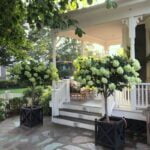For those looking to enhance their small outdoor spaces, decking can be a game-changer. Decking small gardens ideas can provide a versatile and stylish solution for maximizing the potential of limited areas. By adding a deck, homeowners can create an inviting outdoor retreat that seamlessly blends with the natural surroundings while adding value to their property.
The right decking material is crucial in making the most out of a small garden. Whether opting for traditional wood for its warmth and natural appeal, composite for its low maintenance properties, or PVC for durability and versatility, choosing the suitable material can significantly impact the overall look and feel of the space. With the abundance of options available, selecting the ideal decking material is essential to achieve both aesthetic and functional goals in small gardens.
Designing a deck in a small garden requires careful planning to optimize every inch of space effectively. From incorporating vertical gardens to utilizing built-in seating and strategic lighting solutions, there are numerous design tips that can help transform a compact outdoor area into a charming oasis. By implementing smart design ideas, homeowners can create an inviting and functional outdoor space that meets their needs while enhancing the beauty of their small garden.
Choosing the Right Decking Material
When choosing the right decking material for a small garden, it is essential to consider both aesthetics and functionality. The material you select will not only impact the overall look of your outdoor space but also its durability and maintenance requirements. Here are some options to consider:
- Wood: Wood decking, such as cedar or redwood, adds a natural and rustic charm to small gardens. It is relatively affordable and easy to work with, making it a popular choice among DIY enthusiasts.
- Composite: Composite decking is a low-maintenance option that mimics the look of wood without the upkeep. Made from a combination of wood fibers and recycled plastic, composite decking is resistant to fading, warping, and rotting.
- PVC: PVC decking is another low-maintenance alternative that is highly durable and resistant to moisture, stains, and scratches. While it may come at a higher price point, PVC decking requires minimal upkeep and can withstand harsh weather conditions.
Each type of decking material has its advantages and drawbacks, so it’s essential to weigh your priorities when making a decision. Consider factors such as budget, maintenance preferences, aesthetic appeal, and environmental impact before settling on the right material for your small garden.
When shopping for decking materials for your small garden project, be sure to consult with professionals or visit local suppliers for expert advice on the best options available in your area. With the right material choice, you can create a beautiful and functional outdoor space that enhances the beauty and value of your home.
Design Tips for Small Gardens
Designing a small garden with decking requires careful planning and creative solutions to make the most out of limited space. One innovative idea for decking small gardens is to incorporate vertical gardens into the design. Vertical gardens not only add a touch of greenery but also help maximize space by utilizing walls or fences as planting areas.
This is especially beneficial for small gardens where every inch counts. Consider installing vertical planters, hanging baskets, or trellises to create a lush and vibrant display while keeping the ground free for other elements.
In addition to vertical gardens, incorporating built-in seating into your decking design can serve multiple purposes in a small garden. Built-in benches or seating areas not only provide a place to relax and enjoy the outdoors but also save valuable space compared to standalone furniture pieces.
To optimize functionality, consider including storage compartments underneath the seating for stashing cushions, gardening tools, or other essentials. This clever design feature eliminates clutter and enhances the overall aesthetic of the garden deck.
When it comes to lighting in small garden decking ideas, strategic placement of lights can enhance both the ambiance and functionality of the outdoor space. Soft ambient lighting along pathways or staircases can create a welcoming atmosphere while ensuring safe navigation at night.
For task lighting, consider installing spotlights or string lights above dining or lounging areas to illuminate specific zones for activities like dining al fresco or hosting gatherings. Incorporating different types of lighting fixtures can add depth and dimension to your small garden deck while making it functional round-the-clock.
- Consider incorporating vertical gardens using wall planters or hanging baskets
- Include built-in seating with storage compartments underneath for multifunctional use
- Strategically place lighting fixtures for ambiance and practicality on your small garden decking
Maximizing Space
One of the biggest challenges when decking small gardens is maximizing the available space to create a functional and aesthetically pleasing outdoor area. To make the most out of a limited space, consider using multi-functional furniture that serves more than one purpose. Opt for folding tables and chairs that can be stored easily when not in use, or built-in seating with hidden storage compartments to minimize clutter.
Incorporating smart storage solutions into your small garden decking design can help keep the space organized and visually appealing. Utilize vertical shelving units to store gardening tools, pots, and other essentials without taking up valuable floor space. Hanging planters or wall-mounted hooks can also be used to display plants and decorative items while freeing up ground area for seating or walking paths.
Strategic placement of plants is key to creating a balanced and inviting atmosphere in a small garden with decking. Consider using tall grasses or climbers along fences or walls to add depth and create a sense of privacy.
Grouping potted plants of varying heights on different levels, such as shelves or stairs, can also draw the eye upward and make the space feel larger. By incorporating these tips for maximizing space, you can transform your small garden into a cozy retreat that is both stylish and practical.
| Maximizing Space Tips | Details |
|---|---|
| Multi-Functional Furniture | Choose folding tables, built-in seating with storage |
| Smart Storage Solutions | Use vertical shelving, hanging planters |
| Strategic Placement of Plants | Opt for tall grasses, group potted plants on various levels |
Small Garden Decking Layouts
When it comes to decking small gardens, the layout plays a crucial role in maximizing the available space while creating an aesthetically pleasing outdoor area. One popular option for small garden decking layouts is the square design. Square decks are versatile and can easily fit into compact spaces, providing a cozy area for seating or dining. By incorporating built-in benches or planters along the perimeter of the square deck, you can create a seamless and functional design.
Another layout to consider for decking small gardens is the rectangular design. Rectangular decks are great for narrow spaces and can help elongate the appearance of a small garden. This layout works well for creating defined zones within the outdoor area, such as a lounging area, dining space, or even a mini herb garden. By adding trellises or screens to one side of the deck, you can create privacy and vertical interest in your small garden.
For those looking to add a touch of uniqueness to their small garden decking, an L-shaped design might be the perfect choice. L-shaped decks are great for wrapping around corners or following the shape of existing structures in your garden.
This layout creates visual interest and allows for different activities to take place on each section of the deck. By incorporating steps or levels within the L-shaped design, you can add dimension and depth to your small garden decking ideas.
| Deck Layout | Description |
|---|---|
| Square Design | Versatile design that fits well in compact spaces; ideal for adding built-in elements like benches or planters. |
| Rectangular Design | Great for narrow spaces, creates defined zones within the outdoor area; can be enhanced with trellises or screens. |
| L-Shaped Design | Unique layout that wraps around corners or follows existing structures; allows for different activities on each section. |
Maintenance and Care
Regular Cleaning and Inspections
To ensure the longevity and durability of decking in small gardens, it is essential to perform regular cleaning and inspections. Remove debris such as leaves, dirt, and other materials that can accumulate on the deck surface. This will prevent moisture buildup and potential mold or mildew growth. Additionally, inspect the decking for any signs of damage, such as loose boards or nails, and address them promptly to prevent further issues.
Sealing and Staining
One key aspect of maintaining decking in small gardens is sealing and staining the wood to protect it from the elements. Choose a high-quality sealant or stain designed for outdoor use that provides UV protection, water resistance, and durability. Apply the sealant according to manufacturer instructions to maintain the integrity of the wood and enhance its appearance. Regularly check the condition of the sealant and reapply as needed to keep your deck looking its best.
Preventing Rot and Decay
Another crucial step in caring for decking in small gardens is preventing rot and decay. Ensure proper ventilation underneath the deck to allow air circulation and reduce moisture buildup that can lead to wood decay. Use pressure-treated wood or composite materials that are resistant to rotting for added protection.
Trim back plants or foliage that come into direct contact with the deck surface to prevent moisture retention. By taking these preventative measures, you can extend the lifespan of your decking in a small garden and enjoy it for years to come.
Budget-Friendly Decking Ideas
When it comes to decking small gardens, there are plenty of budget-friendly ideas that can help transform your outdoor space without breaking the bank. One popular option for those looking to save money on decking materials is to use pallets. Reclaimed wood pallets can be repurposed into a stylish and functional deck, adding a rustic charm to your garden. Not only are pallets cost-effective, but they are also environmentally friendly as they give new life to old materials.
Another eco-friendly and budget-conscious option for decking in small gardens is using reclaimed wood. Salvaged wood from old structures or furniture can be cleaned up and repurposed as decking material, adding character and uniqueness to your outdoor space. Reclaimed wood not only adds a touch of history and charm to your garden but also reduces the need for new materials, making it a sustainable choice for environmentally conscious homeowners.
For those seeking an even more sustainable approach to decking small gardens, consider using eco-friendly materials such as bamboo or composite decking made from recycled plastic and wood fibers. These materials offer durability, low maintenance, and a long lifespan while minimizing the environmental impact of your garden project. By choosing eco-friendly materials for your decking project, you can create a beautiful outdoor space that aligns with your values and respects the planet.
Expert Advice on Decking Small Gardens
In creating a stunning deck in a small garden and optimizing the limited space available, it is essential to seek expert advice from landscaping professionals. Their insights and recommendations can make a significant difference in transforming your outdoor area into a beautiful and functional oasis. Whether you are looking to enhance an urban balcony, a cozy backyard, or a compact courtyard, professional guidance can help you make the most out of your small garden decking ideas.
Landscaping experts often emphasize the importance of selecting the right decking material for small gardens. From choosing between wood, composite, or PVC options to considering factors like durability, maintenance requirements, and aesthetic appeal, their knowledge can guide you towards making informed decisions that align with your vision and budget. Additionally, professionals can provide valuable design tips tailored to small spaces – maximizing every square foot through innovative features like vertical gardens, built-in seating, and strategic lighting arrangements.
Moreover, landscaping professionals can offer practical solutions for maintaining and caring for decking in small gardens. By providing personalized advice on preserving the integrity of your deck through regular cleaning routines, protective coatings, and timely repairs, they ensure its longevity and visual appeal.
Their expertise extends to layout recommendations as well – suggesting space-saving techniques like multi-functional furniture choices, smart storage solutions, and strategic plant placements to create an inviting environment that suits your lifestyle needs. In essence, seeking expert advice on decking small gardens ideas positions you for success in transforming your outdoor space into a functional and aesthetically pleasing retreat.
Frequently Asked Questions
How Do You Deck a Small Garden?
Decking a small garden involves careful planning to maximize the space available. Consider using multi-functional furniture, vertical gardening techniques, and strategic placement of plants to create a cozy and inviting outdoor space.
What Is the Cheapest Way to Deck Your Garden?
The cheapest way to deck your garden is by utilizing budget-friendly materials such as concrete pavers, pea gravel, or pressure-treated wood. Opting for DIY installation instead of hiring professionals can also help save on costs.
Can I Build a Deck Directly on the Ground?
Building a deck directly on the ground is possible but requires proper preparation to prevent issues such as rotting, warping, or insect infestations. Ensure proper drainage, use pressure-treated lumber, and consider adding a weed barrier to protect the structure in the long run.

Welcome to my gardening blog! I am passionate about plants and enjoy sharing my knowledge and experiences with others. In this blog, I will write about everything related to gardening, from tips on how to get started to updates on my own garden projects.





